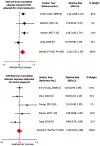Risk of cardiovascular disease associated with exposure to abacavir among individuals with HIV: A systematic review and meta-analyses of results from 17 epidemiologic studies
- PMID: 30040992
- PMCID: PMC7791605
- DOI: 10.1016/j.ijantimicag.2018.07.010
Risk of cardiovascular disease associated with exposure to abacavir among individuals with HIV: A systematic review and meta-analyses of results from 17 epidemiologic studies
Abstract
Objectives: Abacavir's potential to cause cardiovascular disease (CVD) among people living with HIV (PLWH) is debated. We conduct a systematic review and meta-analyses to assess CVD risk from recent and cumulative abacavir exposure.
Methods: We searched Medline, Embase, Web of Science, abstracts from Conference on Retroviruses and Opportunistic Infections, and International AIDS Society/AIDS Conferences and bibliographies of review articles to identify research studies published through 2018 on CVD risk associated with abacavir exposure among PLWH. Studies assessing risk of CVD associated with recent (exposure within last 6 months) or cumulative abacavir exposure across all age-groups were eligible. Risks were quantified using fixed- and random-effects models.
Results: Of 378 unique citations, 68 full-text research articles and abstracts were reviewed. Seventeen studies assessed risk of CVD from recent or cumulative abacavir exposure. Summary relative risk (sRR) is increased for recent exposure (n=16 studies, sRR=1.61; 95% confidence interval: 1.48-1.75), higher in antiretroviral-therapy-naive population (n=5, 1.91; 1.48-2.46) and all studies reported RR>1. The sRR for recent exposure was similarly increased for the outcome of acute myocardial infarction, and for studies that adjusted for substance abuse, smoking, prior CVD, traditional CVD risk factors, and CD4 cell-count/HIV viral load. The sRR was increased for cumulative abacavir exposure (per year) (n=4, 1.12; 1.05-1.20) but no increase was seen after adjusting for recent exposure (n=5, 1.00; 0.93-1.08).
Conclusions: Our findings suggest an increased risk of CVD from recent abacavir exposure. The risk remained elevated after adjusting for potential confounders. Further investigations are needed to understand CVD risk from cumulative exposure.
Keywords: Abacavir; Cardiovascular disease; Human immunodeficiency virus.
Copyright © 2018 Elsevier Ltd. All rights reserved.
Conflict of interest statement
Competing Interests
None.
Figures






References
-
- Bedimo RJ, Westfall AO, Drechsler H, Vidiella G, Tebas P. Abacavir use and risk of acute myocardial infarction and cerebrovascular events in the highly active antiretroviral therapy era. Clin Infect Dis 2011; 53(1):84–91. - PubMed
-
- Durand M, Sheehy O, Lelorier J, Tremblay CL. Association between use of antiretroviral therapy and risk of acute myocardial infarction: A nested case control study using Quebec’s Public Health Insurance Database (RAMQ). J Popul Ther Clin Pharmacol 2011;18(2):el78–9. - PubMed
Publication types
MeSH terms
Substances
Grants and funding
LinkOut - more resources
Full Text Sources
Other Literature Sources
Medical
Research Materials

